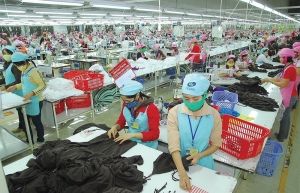INTERNATIONAL INVESTMENT
AND PORTAL
The US Department of Agriculture (USDA) last week led a trade delegation including 50 US businesses, farm organisations, and representatives of nine state departments of agriculture to Vietnam. This was the largest delegation ever in the history of bilateral relations in order to mark the one-year anniversary of the US-Vietnam Comprehensive Strategic Partnership.
 Agriculture holds potential for added US-Vietnam activities - illustration photo
Agriculture holds potential for added US-Vietnam activities - illustration photo
“Vietnam is a big market for US companies in the agricultural sector,” said Under Secretary for Trade and Foreign Agricultural Affairs Alexis Taylor, who is playing an important role in allowing Vietnamese agricultural products to be exported to the United States. “Agriculture plays a huge part of our bilateral trade relationship, and Vietnam now ranks as the United States’ 10th-largest export market for agricultural and food products, while the United States is the largest agricultural export market of Vietnam.”
Those represented in the delegation included Willamar Grain, Cargill, the US Grains Council, SAF Global Policy, the American Feed Industry Association, US Rice Producers Association, and more.
The US firms directly had 500 meeting with Vietnamese companies, and explored the market potentials of Vietnam. Moreover, they will also study activities at supermarkets, stores, visit factories, and production facilities that employ imported materials from the US such as nuts, flour, and cereals.
“Our products exported to Vietnam will be those not produced by Vietnam,” Taylor told VIR. “This mean opportunities for Vietnamese consumers to have more choices.”
According to the USDA, exports of US agricultural and related products to Vietnam, which totalled nearly $3.5 billion in 2023, are recognised by Vietnamese consumers, importers and retailers for their reliability, quality and sustainability. US tree nuts, fresh fruit, poultry, beef and pork are in particularly high demand by Vietnam’s food processing, retail, and restaurant sectors. Nevertheless, fruits exported from the United States to Vietnam are still subject to quite high import taxes, such as plums (20 per cent), blueberries (15 per cent), and tangerines (20 per cent).
“There are many food products that can complement each other between the two countries,” Taylor said. “Especially, many types of Vietnamese fruits are not found in the United States. Meanwhile, US products such as livestock, poultry, and cotton products have great potential in the Vietnamese market. There is still a lot of room for the markets of the two countries to be further exploited.”
She also said that Vietnam and the United States are now discussing how to export the former’s passion fruit to the latter. In principle, export of fresh fruits would need to meet strict requirements in food safety and hygiene in order that there will be no strange germs that can penetrate the US market from Vietnam and vice versa.
It is calculated that the US market consumes about 12 million tonnes of fruits a year. Domestically produced products can meet 70 per cent of demand, and the remaining 30 per cent, or 3.6 million tonnes, must be imported.
“The United States is one of the most demanding markets in the world but has large demand for fresh fruits,” said Vietnamese Deputy Minister of Agriculture and Rural Development Tran Thanh Nam. “The two governments are working with each other to export more products into their respective markets.”
The United States is now Vietnam’s largest agro-fishery export market, reaching $8.58 billion in the first eight months of this year – up 23.5 per cent on-year, and accounting for 21.4 per cent of Vietnam’s total agro-fishery export turnover. Last year, the figure was $10.96 billion, responsible for 20.7 per cent.
Taylor said that she believed the US-Vietnam trade ties will continue flourishing thanks to both sides’ growing demand, and there will be more Vietnamese products that can be exported to the United States.
According to the US Embassy to Vietnam, the close cooperation between both sides in promoting agricultural products and bilateral trade is another testament to the commitment between the two countries in forging a better future for people in the United and Vietnam.
“We see tremendous opportunities in Vietnam for US goods and services in fields such as agriculture, aviation, education, energy, health, and information communications technology, just to name a few,” the embassy stated.
To cement agricultural cooperation, the United States is extending its support for Vietnam. In an example, the US Agency for International Development a few months ago launched a partnership with Vietnam’s Agribank and VPBank to expand finance opportunities for small and growing enterprises in the agriculture sector.
In addition, the USDA has also signed an MoU with Vietnam’s Ministry of Agriculture and Rural Development’s Plant Protection Division to make better use of fertiliser to reduce costs, greenhouse gas emissions, and water pollution.
 US considers upgrading Vietnam’s economy status
US considers upgrading Vietnam’s economy status
The US is considering the recognition of Vietnam as a market economy, which means that Vietnamese goods entering the US would avoid many risks caused by trade barriers.
 Building on 30 years of US-Vietnam advancements
Building on 30 years of US-Vietnam advancements
This year marks the 30th anniversary of the American Chamber of Commerce and the beginning of US-Vietnam economic relations, and our members now account for billions of US dollars in foreign investment, tens of thousands of direct employees, hundreds of thousands of indirect employees, and a significant share of Vietnam’s exports and tax revenues.
 US and Vietnam build momentum with upgraded ties
US and Vietnam build momentum with upgraded ties
In the six months since the historic upgrade of the US-Vietnam relationship to a Comprehensive Strategic Partnership, the United States and Vietnam have built on the momentum of our elevated relationship to advance bilateral cooperation across a range of areas.

















